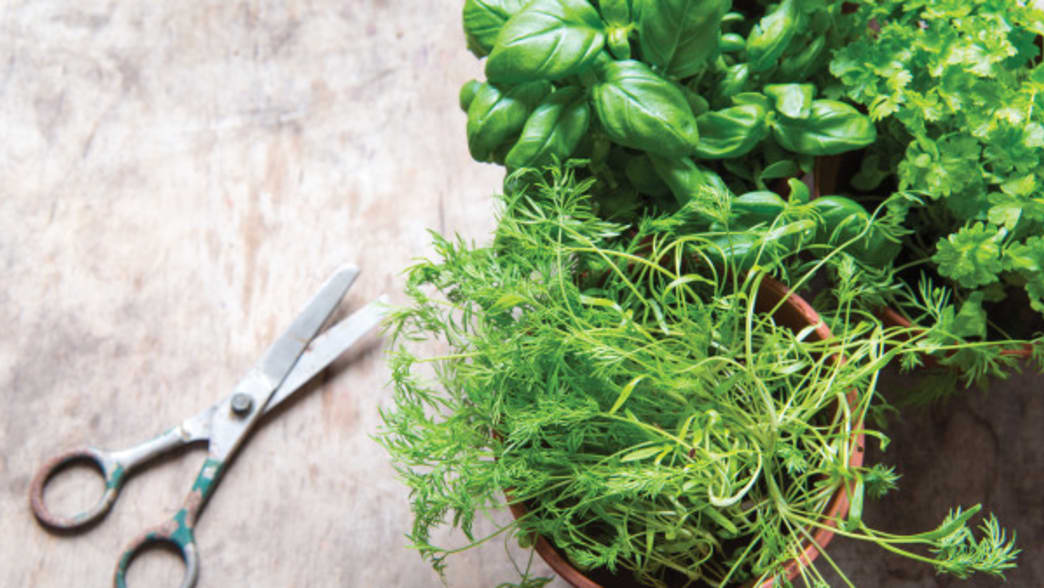Grow Your Own Herbs
You need a surprisingly small space (hello, one pot!) to reap all the incredible flavor, freshness and cost benefits of growing some of your own herbs. Choose varieties you use often in your cooking (I personally love basil and cilantro). It’s an eco-friendly alternative to buying bunches of different herbs wrapped in plastic and shipped from far-flung locales.
Add Fair Trade Flair to Your Spice Pantry
Stock up on some new Fair Trade–certified spices for more than just a flavor and phytochemical boost. Fair Trade follows specific agricultural, environmental and labor practices that help preserve natural ecosystems and rainforests, both of which act as vital carbon sinks for the planet.
Shed Pounds with Pulse Protein
According to the Academy of Nutrition and Dietetics, plant-based diets are more sustainable than diets rich in animal products because they use fewer resources and are associated with less environmental damage. Researchers from the University of Copenhagen have added another surprising benefit: In a recent study, participants who ate a high-protein meal using legumes in place of meat consumed 12% fewer calories at the next meal.
Shave Something New Into Your Salads
Not sure what to do with those stragglers in your veggie bin like those last few Brussels sprouts or bit of cabbage? Shave ’em raw into your salads. According to the United States Department of Agriculture (USDA), between 30 to 40% of all food in the US goes to waste. When tossed in a landfill, food waste quickly generates methane – one of the main culprits of global warming. The bonus? You get a burst of eye-popping color, prebiotic fibers that support digestive health and a powerful phytochemical punch.
Add Peas & Peanuts to Your List
Choosing foods that regenerate and revitalize soil is one of the top trends of 2017. Peas and peanuts are two versatile and budget-friendly protein options that fit the bill: They have the ability to naturally replenish valuable nutrients like nitrogen back into the soil, which helps reduce the need for chemical fertilizer.
Toss Rhubarb into Your Smoothie
You don’t have to swear off exotic fruits from your morning smoothie altogether, but you can cut back on some of their environmental costs (such as freezing or air-freighting) by shaking things up with local beauties. Nothing says spring like the crimson, happy flush of rhubarb! It also pairs wonderfully with sweet fruits, making it a perfect new addition to your smoothie this month (1 cup diced is a scant 26 calories, but it packs 2 grams of fiber and is a good source of vitamin K).
Try Jackfruit or Edible Insects
Looking for more delicious, climate-friendly protein swaps to add to your plate? Jackfruit, a meaty-tasting fruit from the jack tree, and edible insects are increasingly showing up in grocery-store aisles, from snack bars to roasted, seasoned cricket snacks. While Americans have typically struggled with the concept of eating bugs, it may not be all that fringe. According to the Food and Agriculture Organization of the United Nations (FAO), edible insects are a sustainable and highly nutritious protein source that are already consumed by at least 2 billion people worldwide.
Top Toast with Seasonal Picks
As we step into spring, eating locally is an incredibly tasty way to help slash food miles
and reduce the energy needed to transport and store food. Hit the farmers’ market
and let your inner artist flourish: From fresh pea hummus topped with grilled artichokes to morel mushrooms with asparagus to fava bean purée with roasted fennel, remember that “what grows together, goes together.” Top these in-season superstars with a sprinkle of fresh herbs and toasted seeds for a nutritious breakfast or snack.
Written by Kate Geagan for Clean Eating Magazine and legally licensed through the Matcha publisher network. Please direct all licensing questions to legal@getmatcha.com.

